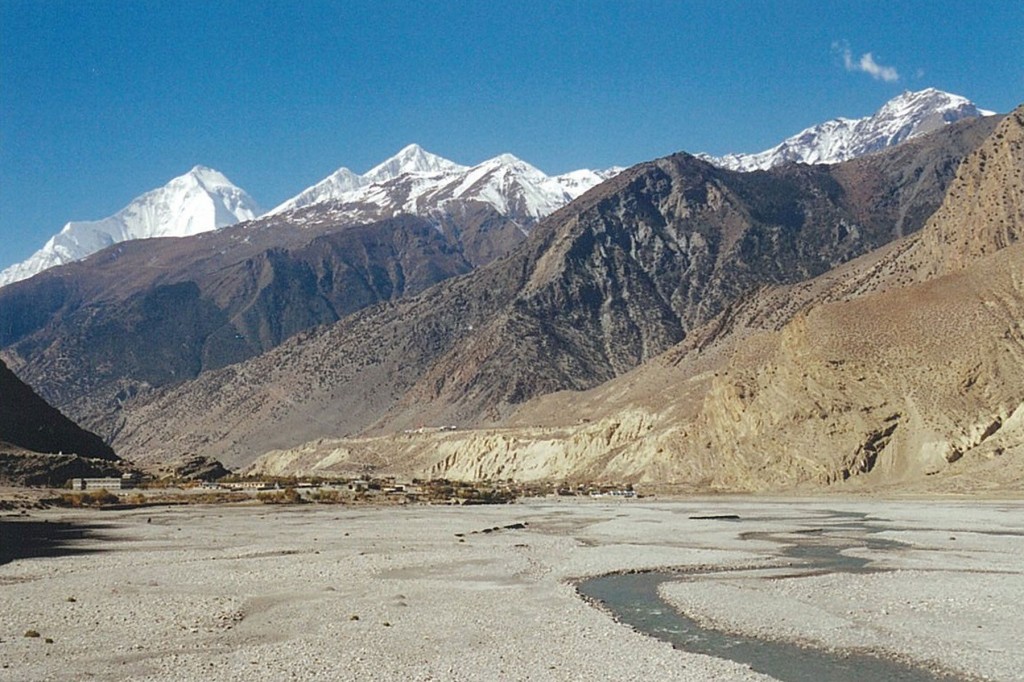In one week, Cheryl and I leave for the Kingdom of Lo. For thirty years, I have fitfully hoped to someday see Tibet. Not the Tibet of today, as conquered by the Han Chinese, but more the Tibet I first read about in Heinrich Harrar’s account of his Seven Years there, 1942-49. The Tibet with just one truck, one movie projector, and a surfeit of monks. Where Every Breath Is A Prayer.
Despite a planned trip in 1988, we never got there. Life kept happening to me, and I thought it would become one more Road Not Taken. Then, in October 2012, I read about a trip to Mustang, in Nepal. I printed off a copy, filing it in a slim folder containing trips I one day hoped to take.
Cheryl has always cajoled me to travel more, outside the country, to unfamiliar places, where we could lose our modern selves. It’s been a point of contention for us throughout our life together. She would challenge me, I would plead the need to honor work and personal commitments, and it never happened. She visited China in 1986, then Mongolia and Haiti in this century.
With our mutual retirements two years ago, the external barriers melted away, and I was left with just my own fears and inertia. Last year, we hopped down to Chile and Peru, visiting the Atacama and Machu Picchu, which finally opened up the world for us. Cheryl had gone to Nepal (without me) the previous fall, and lusted to go back. I dusted off the Mustang notes, and Cheryl claims she independently discovered the place herself. Stars began aligning, and we committed to going this coming November.
Investigation into ideal times for visiting showed that, what with weather, and our own commitments to triathlon and Haiti, late April/May was probably ideal, so we switched up the timetable. Somehow, we both agreed on the time and place, and now are left with the actual trip looming. I admit to being a little fearful.
Mustang, the Kingdom of Lo, is a rather small protuberance of Nepal into the mass of Chinese Tibet. Lying north of the Himalayan spine (Annapurna and Dhaulagiri, two of the 8 tallest mountains in the world, define the southern boundary), Mustang shares topography, climate, culture, religion, and language with Tibet. However, it has retained an earlier form of Tibetan Buddhism, exemplified by the “Red Hat” sects. In the 14th century, a great Mustangi lama, Ngorpa, founded three monasteries, whose impact remains to this day. Simultaneously, a local chieftain, Ame Pal, consolidated the several indigenous fiefdoms into one Kingdom, whose line extended into the 21st century.
Shortly thereafter, Tibetan Buddhism underwent a wave of reformation, exemplified by the first incarnation of the Dalai Lama, who appeared in 1405. Mustang was untouched by these changes, lying equally far between the two primary centers of Tibetan culture in Lhasa and Ladakh. Even though its people speak and write a dialect of Tibetan, share fundamental religious tenets with Tibetans, and appear ethnically as cousins to them, nonetheless, they have evolved (or one might say stagnated) into a distinct offshoot of that culture.
Geography and politics have guided this divergence. For almost its entire length, the Himalayan crest divides two major river systems, the Ganges and the Brahmaputra. Both flow west to east, one on the Himalaya’s southern flank, the other on its north. At the southeastern corner of the Tibetan Highlands, the Brahmaputra suddenly dives south and down, joining the Ganges in its massive delta in Bangladesh.
But that Himalayan crest is pierced in one spot, between Dhaulagiri and Annapurna, through which the Kali Gandaki flows south to the Ganges. The upper reaches of the Kali’s valley – Mustang – became the true barrier between Hind and Mongol cultures. As local principalities and kingdoms consolidated, primarily in response to British influence in the Indian sub-continent, the southern slopes of the Himalayas coalesced into the country we now know as Nepal. As this happened, the King of Mustang in the late 18th century agreed to become a part of the larger nation, but without giving up his title and rights as monarch to his local lands.
These geopolitical forces allowed the high, rugged desert region of Mustang to remain quite isolated from influences both to the south (those Himalayan peaks make a formidable barrier) and the north (again, a series of passes approaching 20,000 feet separates them from their Tibetan cousins). Lying along the “Salt Road” extending from the East-West Silk Road in the North through Tibet to Hindu lands in the South, the meagre populace consolidated local deficits – narrow, treacherous mountain passes, a dry, unforgiving climate – into assets which sustained a remarkably robust culture of herders, traders, and monks.
Their relative isolation persisted into the mid-20th century. For over 600 years, a unique and almost unchanging way of life evolved in this land which lies between 11,000 and 15,000 feet, with mountainous ridges over 20,000 feet rising on all four sides. The world’s deepest canyon, that of the Kali Gandaki, is the only exit, at about 10,000’ Even today, no real road traverses the entire region.
(To Be Continued)

